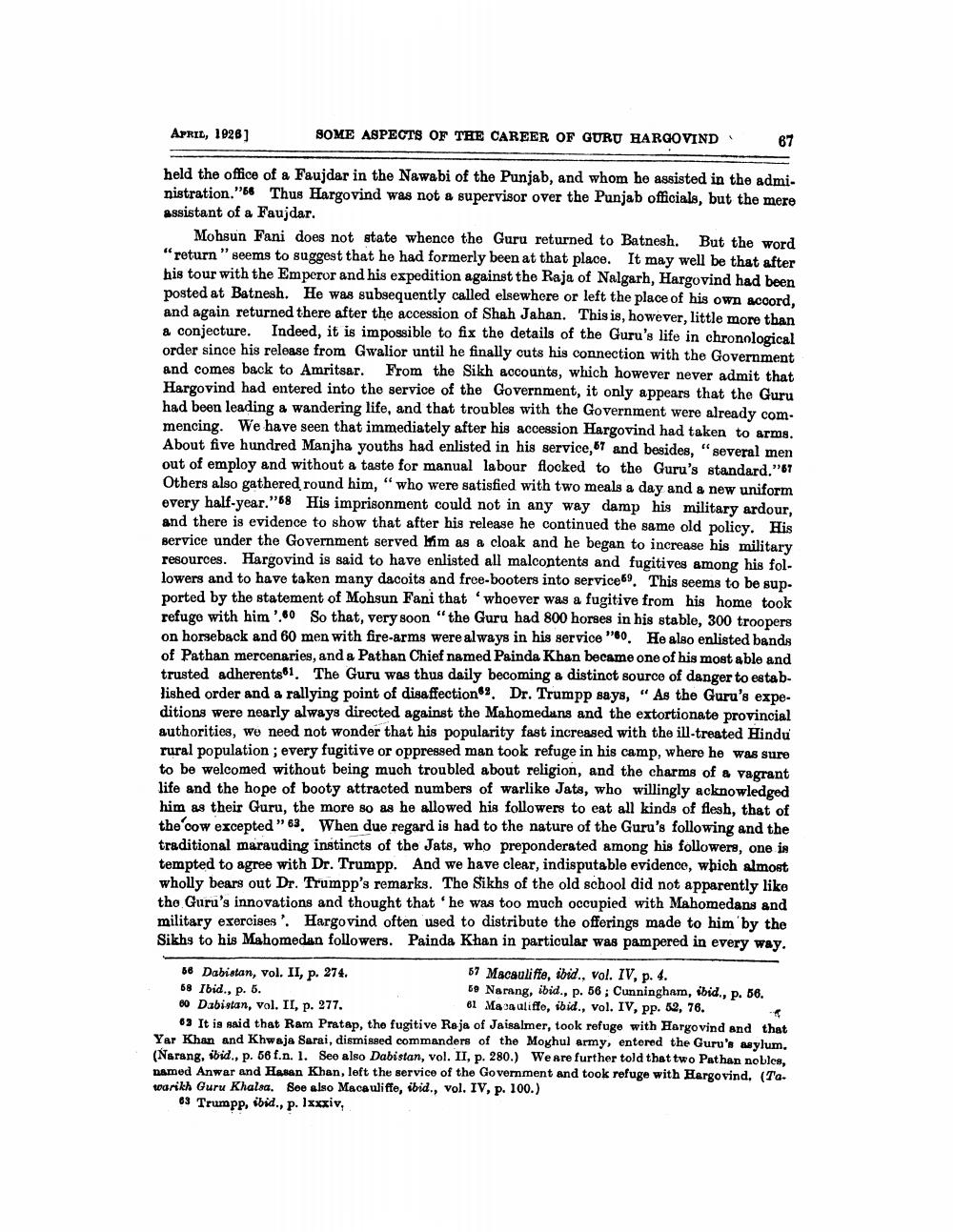________________
APRIL, 1928)
SOME ASPECTS OF THE CAREER OF GURU HARGOVIND
67
held the office of a Faujdar in the Nawabi of the Punjab, and whom he assisted in the admi. nistration."66 Thus Hargovind was not a supervisor over the Punjab officials, but the mere assistant of a Faujdar.
Mohsun Fani does not state whence the Guru returned to Batnesh. But the word "return " seems to suggest that he had formerly been at that place. It may well be that after his tour with the Emperor and his expedition against the Raja of Nalgarh, Hargovind had been posted at Batnesh. He was subsequently called elsewhere or left the place of his own accord, and again returned there after the accession of Shah Jahan. This is, however, little more than a conjecture. Indeed, it is impossible to fix the details of the Guru's life in chronological order since his release from Gwalior until he finally cuts his connection with the Government and comes back to Amritsar. From the Sikh accounts, which however never admit that Hargovind had entered into the service of the Government, it only appears that the Guru had been leading a wandering life, and that troubles with the Government were already commencing. We have seen that immediately after his accession Hargovind had taken to arms. About five hundred Manjha youths had enlisted in his service, 67 and besides, "several men out of employ and without a taste for manual labour flocked to the Guru's standard."67 Others also gathered round him," who were satisfied with two meals a day and a new uniform every half-year,"68 His imprisonment could not in any way damp his military ardour, and there is evidence to show that after his release he continued the same old policy. His service under the Government served lim as a cloak and he began to increase his military resources. Hargovind is said to have enlisted all malcontents and fugitives among his followers and to have taken many dacoits and free-booters into service69. This seems to be sup. ported by the statement of Mohsun Fani that whoever was a fugitive from his home took refuge with him '.80 So that, very soon "the Guru had 800 horses in his stable, 300 troopers on horseback and 60 men with fire-arms were always in his service '60. He also enlisted bands of Pathan mercenaries, and a Pathan Chief named Painda Khan became one of his most able and trusted adherents&1. The Guru was thus daily becoming a distinct source of danger to established order and a rallying point of disaffection. Dr. Trumpp says, “As the Guru's expeditions were nearly always directed against the Mahomedans and the extortionate provincial authorities, we need not wonder that his popularity fast increased with the ill-treated Hindu rural population ; every fugitive or oppressed man took refuge in his camp, where he was sure to be welcomed without being much troubled about religion, and the charms of & vagrant life and the hope of booty attracted numbers of warlike Jats, who willingly acknowledged him as their Guru, the more so as he allowed his followers to eat all kinds of flesh, that of the cow excepted "63. When due regard is had to the nature of the Guru's following and the traditional marauding instincts of the Jats, who preponderated among his followers, one is tempted to agree with Dr. Trumpp. And we have clear, indisputable evidence, which almost wholly bears out Dr. Trumpp's remarks. The Sikhs of the old school did not apparently like the Guru's innovations and thought that he was too much occupied with Mahomedans and military exercises'. Hargovind often used to distribute the offerings made to him by the Sikhs to his Mahomedan followers. Painda Khan in particular was pampered in every way.
66 Dabistan, vol. II, p. 274.
57 Macauliffe, ibid., vol. IV, p. 4. 58 Ibid., p. 5.
69 Narang, ibid., p. 56; Cunningham, ibid., p. 56. 60 Dabistan, vol. II, p. 277.
61 Manulifto, ibid., vol. IV, pp. 42, 76. 63 It is said that Ram Pratap, the fugitive Raja of Jaisalmer, took refuge with Horgovind and that Yar Khan and Khwaja Sarai, dismissed commanders of the Moghul army, entered the Guru's asylum. (Narang, ibid., p. 58 f.n. l. See also Dabistan, vol. II, p. 280.) We are further told that two Pathan nobles, named Anwar and Hasan Khan, left the service of the Government and took refuge with Hargovind, (Ta. warikh Guru Khalsa. See also Macauliffe, ibid., vol. IV, p. 100.)
63 Trumpp, ibid., p. Ixxxiv,




